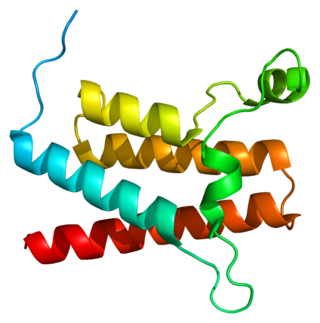Top Qs
Timeline
Chat
Perspective
SMARCA4
Protein-coding gene in the species Homo sapiens From Wikipedia, the free encyclopedia
Remove ads
Transcription activator BRG1 also known as ATP-dependent chromatin remodeler SMARCA4 is a protein that in humans is encoded by the SMARCA4 gene.[5]
Remove ads
Function
Summarize
Perspective
The protein encoded by this gene is a member of the SWI/SNF family of proteins and is similar to the brahma protein of Drosophila. Members of this family have helicase and ATPase activities and are thought to regulate transcription of certain genes by altering the chromatin structure around those genes. The encoded protein is part of the large ATP-dependent chromatin remodeling complex SWI/SNF, which is required for transcriptional activation of genes normally repressed by chromatin. In addition, this protein can bind BRCA1, as well as regulate the expression of the tumorigenic protein CD44.[6]
BRG1 works to activate or repress transcription. Having functional BRG1 is important for development past the pre-implantation stage. Without having a functional BRG1, exhibited with knockout research, the embryo will not hatch out of the zona pellucida, which will inhibit implantation from occurring on the endometrium (uterine wall). BRG1 is also crucial to the development of sperm. During the first stages of meiosis in spermatogenesis there are high levels of BRG1. When BRG1 is genetically damaged, meiosis is stopped in prophase 1, hindering the development of sperm and would result in infertility. More knockout research has concluded BRG1's aid in the development of smooth muscle. In a BRG1 knockout, smooth muscle in the gastrointestinal tract lacks contractility, and intestines are incomplete in some cases. Another defect occurring in knocking out BRG1 in smooth muscle development is heart complications such as an open ductus arteriosus after birth.[7][8]
Remove ads
Clinical significance
Summarize
Perspective
BRG1 (or SMARCA4) is the most frequently mutated chromatin remodeling ATPase in cancer.[9] Mutations in this gene were first recognized in human cancer cell lines derived from adrenal gland[10] and lung.[11] Later it was recognized that mutations exist in a significant frequency of medulloblastoma and pancreatic cancers, and in many other tumor subtypes.[12][13][14]
In cancer, mutations in BRG1 show an unusually high preference for missense mutations that are frequently heterozygous and target the ATPase domain.[15][9] Mutations are enriched at highly conserved ATPase sequences,[16] which lie on important functional surfaces such as the ATP pocket or DNA-binding surface.[15] These mutations act in a genetically dominant manner to alter chromatin regulatory function at enhancers[15] and promoters.[16]
Mutations of BRG1 are associated with context-dependent expression changes at MYC-genes, which indicates that the BRG1 and MYC proteins are functionally related.[15][11][17] Another study demonstrated a causal role of BRG1 in the control of retinoic acid and glucocorticoid-induced cell differentiation in lung cancer and in other tumor types. This enables the cancer cell to sustain undifferentiated gene expression programs that affect the control of key cellular processes. Furthermore, it explains why lung cancer and other solid tumors are completely refractory to treatments based on these compounds that are effective therapies for some types of leukemia.[18]
The role of BRG1 in sensitivity or resistance to anti-cancer drugs had been recently highlighted by the elucidation of the mechanisms of action of darinaparsin, an arsenic-based anti-cancer drugs. Darinaparsin has been shown to induce phosphorylation of BRG1, which leads to its exclusion from chromatin. When excluded from the chromatin, BRG1 can no longer act as a transcriptional co-regulator. This leads to the inability of cells to express HO-1, a cytoprotective enzyme.[19]
Remove ads
Interactions
SMARCA4 has been shown to interact with:
- ACTL6A,[20][21]
- ARID1A,[20][21]
- ARID1B,[22][23]
- BRCA1,[24][25]
- CTNNB1,[26]
- CBX5,[27]
- CREBBP,[28][29]
- CCNE1,[30][31]
- ESR1,[28][32]
- FANCA,[33][34]
- HSP90B1,[33]
- ING1,[35]
- Myc,[36][37]
- NR3C1,[38][39]
- P53,[40]
- POLR2A,[20][21][41]
- PHB,[42]
- SIN3A,[35][41]
- SMARCB1,[20][21][33][41][43]
- SMARCC1,[20][21][33][41]
- SMARCC2,[20][21][33]
- SMARCE1,[20][21]
- STAT2,[44] and
- STK11.[45]
References
Further reading
External links
Wikiwand - on
Seamless Wikipedia browsing. On steroids.
Remove ads








